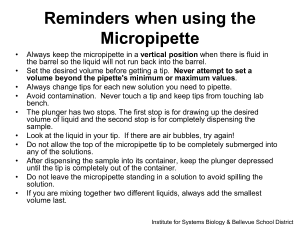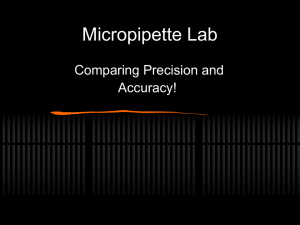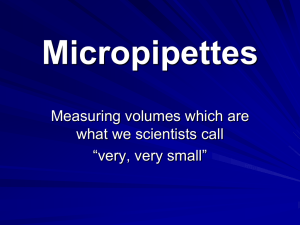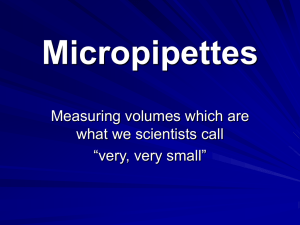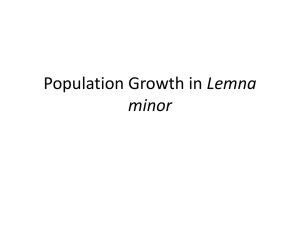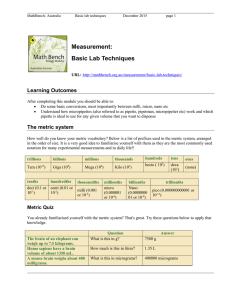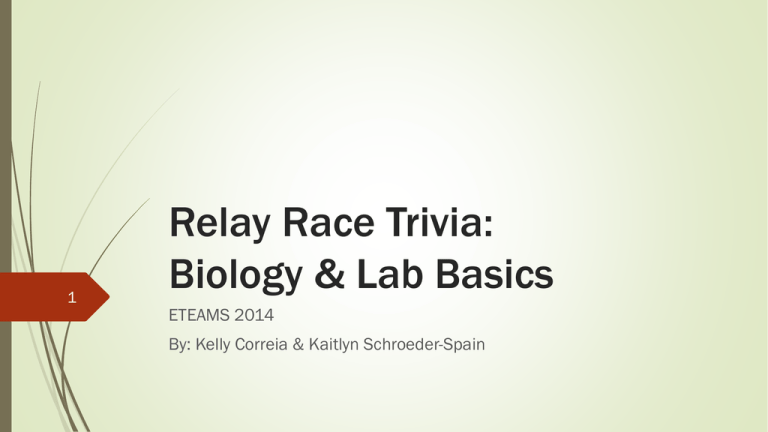
1
Relay Race Trivia:
Biology & Lab Basics
ETEAMS 2014
By: Kelly Correia & Kaitlyn Schroeder-Spain
2
Introduction
Discuss topics and information relevant to ecotoxicology project
and basic/general biology
Expect this material to show-up in the trivia section of the relay
race!!
Topics include:
Common glassware & use
Laboratory equipment & use
Anatomy: Male vs. Female Blue
Crabs
Basic Biology Review
3
Volumetric Flask
Aka a measuring flask
Usually pear shaped
Used to obtain a precise & accurate
volume of a solution
Mixing: insert cap, secure with parafilm, and invert
Range of sizes, commonly 25 mL – 2 L
4
Petri Dish
Also called a cell culture dish. Consists of a plate + lid
Commonly used in microbiology laboratories and
courses
Microbiological cultures can be grown in petri dishes of
differing sizes
Often have a thin layer of growth medium, ex: agar
5
Beakers
Commonly used in laboratories for stirring, mixing and
heating liquids
Not used to measure precise volumes
Large range of sizes: milliliters to liters
6
Graduated Cylinder
20 mL
Used to measure solution volume
More accurate and precise method
of measurement than beakers
Less accurate and precise than
volumetric glassware or volumetric
pipettes
Meniscus: the curved upper
surface of a liquid in a tube.
Bottom of Meniscus is used for
measurements; should sit directly
on the mark
Pipettes
7
Several types, but all used to measure relatively small amounts of
solutions and samples. Some are disposable, others only partly.
Disposable pipettes
-similar to “droppers”
-Plastic
- Often used only once
- For small samples &
crude measurements
Pasteur Pipette
-Blubs may be reused, or not
-Glass is disposable
-Crude, small measurements
Volumetric Pipette (+ bulb)
-Blubs reusable
-Glass disposable
-marked like graduate cylinder
8
Micropipettes
Non-disposable; provide the highest
degree of precision and accuracy
Can be single-channel or multi-channel
Pipette tips:
Are disposable
Can be sterile (usually boxed) or nonsterile (usually in a bag)
Come in a variety of sizes, depending on
pipette & volume of sample
Multichannel pipette
9
Micropipette Use: Basics
Each brand is slightly different, but also similar
• Sample Volume: will determine the pipette and tip size used (Table 1)
• Change volume: turn plunger OR a separate knob; often you’ll hear a
clicking sound
• Eject tips: push eject button
• Pipetting session will provide actual training
Table 1. Example Pipette &Tip Sizes, Volumes
Pipette type
Volumes (μL)
Tip color
P10
0.5 – 10
white
P20
2 – 20
yellow
P200
20 – 200
yellow
P1000
200 – 1000
blue
How
To
Read
a
10
Micropipette
1. Confirm range: labeled on plunger & often one side
• Range will determine decimal places, do not rely
on colors for determination
• Note: knobs turn beyond their range, and can
break
P1000
Panel P1000
View Values
1
1000’s
0
0
100’s
10’s
= 1000 µL
(1 mL)
P200
Panel
View
2
0
0
P200
Values
100’s
P20
Panel
View
2
P20
Values
10’s
10’s
1’s
0
0
1’s
decimal
= 200 µL
(0.2 mL)
= 20 µL
(0.020 mL)
11
How To Read a Micropipette, Example # 2
P1000
Panel P1000
View Values
0
1000’s
5
0
100’s
10’s
= ____ µL
(0.5 mL)
P200
Panel
View
1
8
5
P200
Values
100’s
P20
Panel
View
1
P20
Values
10’s
10’s
1’s
5
2
1’s
decimal
= ____ µL
(0.185 mL)
= ____ µL
(0.0152 mL)
12
Conversions (self study/Reference)
• Expect to convert between different volumes of solutions
• Practice and review will be covered during pipetting and graduated
cylinder sessions
13
Stir Bar & Stir Plates
• Both are used to mix a solution
thoroughly
• Help avoid and/or assist manual stirring
• Stir bars are magnetic, plastic and
reusable; come in a variety of sizes and
shapes
• Stir plate is also magnetic, to move stir
bar
• Stir bar is gently dropped into a solution
and placed on stir plate; plates have
several speeds
• Use a Stir Bar Stick or Retriever to
remove stir bar from solution (also
magnetic)
Stir bars (above)
Stir Bar Stick/Retriever
(right)
Stir plates
14
Hot Plate & Stirrer/Hot Plate Combo
Hot Plate (alone)
• Used to heat a solution, often to assist
with mixing (increase solubility)
• Turn dial to change heat level
Stirrer/Hot Plate (combo)
• Used to mix AND heat a solutions,
• Turn separate dials to change heat level
and stirring speed
15
Centrifuges
• Used to separate samples by weight, size
• Can be “micro” (table top) or very large
• As rotor spins heavier particles separate
on bottom of centrifuge tube
• Produces a supernatant & a pellet, which
can be separated, re-suspended (pellet),
and spun at higher speeds if necessary
• Centrifuge speed varies with size of
centrifuge rotor and can vary with overall size
• Desired molecules, enzymes, etc. will
determine speed necessary for separation
16
Seawater & Salinity
Salinity “units”
Oceanic World avg. 35.5 PSU
PSU = practical salinity scale
Estimate of ionic content
1 PSU = 1 g/kg
Old method: expressed as %, or ppt (parts
per trillion). Known as Knudsen salinities.
Laguna Madre = unique! Hypersaline
Lagoon
Blue crab tanks are kept at 18-20 PSU
Measure salinity using the refractometer
What salinity is the image showing on the
left?
17
Crab Sex Identification
18
•
•
Abdominal apron, or flap, is shaped differently for ♀ & ♂
• ♀: upside down “U” = mature; upside down “v” immature
• ♂: pillar shape, & slender entire life cycle
Claws different colors
• Immature ♀,♂: claws appear greenish/white, with hot pink dots
• Mature ♀: claws are bright orange / red
• Immature ♂: claws are blue, sometimes greenish-blue
19
Female Blue Crabs (FYI)
•
Abdominal apron, or flap, is used to carry eggs
Plant VS Animal Cell (Major Differences)
20
Animal cells: no cell wall; can have flagella, cilia & lysosomes
Plants: cell wall, chloroplasts
21
DNA Structure
• Genetic information for all
living things
• Humans have 46
chromosomes, or 23
pairs
• 1 pair sex
chromosomes
• 22 pairs = autosomes
• Meiosis
• 24,000 genes ( = 2%
of entire DNA)
• 95 % identical to
chimpanzee
• ~ 50 % identical to
bananas
22
RNA Structure
23
5 Kingdoms of all living things
Monera (includes Eubacteria and Archeobacteria)
Protista
Fungi
Plantae
Animalia
24
Stages of Mitosis (IPMAT)
*Be able to put images of Mitosis in order for relay race
25
Structure of a water molecule
• Be able to draw or create a water molecule, including charges and bonds
• Water = 2 Hydrogen atoms covalently bonded with Oxygen
• Water is bipolar because:
• electronegativity of Oxygen + electropositivity of 2 Hydrogen atoms
• Bonds between water molecules = hydrogen bonds
26
1. Carl Linnaeus
2. Charles Darwin
3. Louis Pasteur
4. Gregor Mendel
5. Watson and Crick (+Franklin)
6. Rachel Carson
27
Carl Linnaeus (1707 – 1778)
“father of biological systematics and
nomenclature”
He invented the modern classification
system of living organisms
Binomial nomenclature
e.g., blue crabs = Callinectes sapidus
28
Charles Darwin (1809 – 1882)
Naturalist and Geologist
Voyage of the Beagle (1831 – 1836)
Origin of Species (1859)
Theory of Evolution
all species of life have descended over time from
common ancestors
29
Louis Pasteur (1822-1895)
Chemists and microbiologist
Created first vaccinations for rabies and anthrax
Primary founder of microbiology (along with Cohn & Koch)
Proved that most infectious diseases are caused by microorganisms
Known as the germ theory of disease
Developed pasteurization process
Prevent milk and wine from becoming contaminated with
bacteria
30
Gregor Mendel (1822 – 1884)
Most known for his famous hereditary
experiments with pea plants (1856-1853)
Mendelian Laws of Inheritance, work with
peas and flowers; studied phenotypes of
several generations
Discovered the basics of Genetics by
crossing/mating peas with different physical
traits
31
James Watson (1928 - ) and Francis Crick
(1916-2004) + Rosalind Franklin (1920 -1958)
Watson (left) & Crick (Right) worked at
Cambridge University
Discovered & published DNA structure (1953)
Attended Franklin’s lecture
Rosalind, with others (Wilkins), worked at
King’s College
She studied x-ray diffraction of DNA, helped
ID phosphate “bone” and helix structure
1962: Watson, Crick, and Wilkins won the
Nobel Prize for physiology/medicine
Franklin died in 1958; no posthumous prizes
32
Rachel Carson (1907-1964)
Author, Silent Spring (1963) and
several other books
Focused on effects of DDT and other
pesticides
One of the most influential people of
the 20th century
Famous for advancing the global
environmental movement

![【我們是你的百姓】 [ We are Your people ] 新歌頌揚377 我們屬於祢都](http://s2.studylib.net/store/data/005298903_1-fa3ea08f8bad91a00d5f15d00abd2df9-300x300.png)
